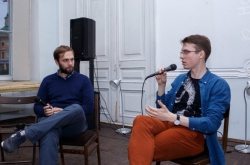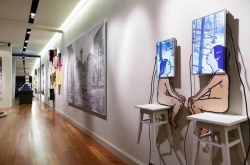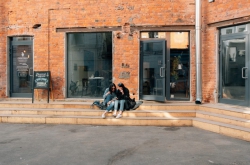Which sort of social research does the Laboratory focus on, and who are its staff?
We assess how good the quality of life is, how happy are the people, what practices are commonplace in a given urban area, and the differences between the "natural" and administratively defined districts of the city. Our team is an interdisciplinary one: I am a sociologist, we also have architects, urban planners, real estate and IT specialists. Combining these competencies allows us to perceive the people in an urban space in a comprehensive manner. We focus our research on such topics as city emotions, as well as cities' natural habitats that can be defined based on data from social networks and have borders different from those of the administrative districts. We also analyze city voids, a subject that few urban specialists pay attention to, as we believe that city voids are a particular kind of resource. We study the diversity of services and work with the citizens' subjective perception of these services in an attempt to define the clusters of interesting services. Apart from research, we also work on projects that have to do with design of open and closed public spaces.
Tell us about your research on the citizens' emotions in different districts of St. Petersburg.
Our research involved the collection of particular data and the development of a platform for its collection. We created mobile and desktop versions of our website Imprecity where people can tag emotions on the city map and add comments explaining why they feel particular emotions in particular places. We gather information about such public spaces as streets, parks, and squares, of which there are very few good ones today. This data will be used for a project on these territories' development. Thus, Imprecity's results offer a mechanism for monitoring the quality of life and urban environment, which is an important part of the Smart St. Petersburg program.

We've noticed that people are more inclined to mark such emotions as happiness than those of sorrow, fear, and anger. We assume that it is easier for them to share happiness, though there might be other explanations which we are currently looking into. St. Petersburg’s citizens feel the most happiness in the central parts of the city, the historical districts. For the most part, that would be the Nevsky prospect, the Peter and Paul Fortress, and the Rubinstein Street; of the places that are further from the city center, one can name the 300th Anniversary park. What we find quite strange is that negative emotions are also concentrated in the city center. Sometimes, the very same place inspires both positive and negative emotions, for instance, the Vosstaniya Square. In this case, people feel happy because it is a spot popular with street musicians, but the nearby train station and the associated factors, like crowds, noise, and thieving, bring out negative emotions. People also have ambivalent feelings about the Galeria mall; few experience really positive emotions in this place, but many report extremely negative sensations.
Amongst the curious places that induce negative emotions is the Sennaya square. Many believe it to be unsafe, and associate their fear with the nearby marketplace where many migrants work, as ethnic conflicts remain a sensitive issue for St. Petersburg.
Most positive and negative emotions are concentrated in the city center; the places that are further from it are associated with fewer emotions. Speaking of positive emotions, people like beautiful scenery, greenery, musicians, cafes and bars, an opportunity to sit down and rest. As you can see, there’s nothing out of the ordinary, the happiness of a city is based on the simplest of things. As for what people don't like, that would be crowds, noise, the feeling of insecurity, and disorder, which are, too, simple factors that can be eliminated.

Still, some districts on the map are even associated with disgust. Why does that happen?
Oftentimes, the reason is boredom, though it's less often mentioned as a negative factor than the more apparent problems: potholes, dilapidation, and such. If people have nowhere to go to, they automatically become bored, and such a place becomes a blind spot on their mental map, which greatly affects its emotional background. Amongst such places is St. Petersburg's grey belt, the former industrial areas along Obvodny Canal. In these places, we observe sadness: people feel sorry that the once-beautiful buildings are now almost ruined. These emotions are more about being sad than angry, but still, all of this are red flags for the government that point at problems that have to be dealt with.
In another research, you showed the difference between people's "natural" habitats and districts as they are defined officially. What is that about?
This research is still in process, so for now, we can only share provisional results. In this project, we wanted to combine the analysis of data from social networks with field sociology. In order to define the key clusters of St. Petersburg, we derived data from VK. The data we got is not good enough, and we'll have to spend a lot of time processing it in order to conduct an adequate analysis, but we are working on it. Oftentimes, when going to different establishments, people post about it using geotags. This data can be used to study how particular places are interconnected via users. Let's say you went to a bar on the Rubinstein Street, and then to a cafe on the Nevsky prospect, and checked in at both places. This way, you've connected them via yourself, the user. The clusters that we define on the city map reflect this practice of check-ins, and thus we learn how people use various places. In this case, we're interested in how habitats reflect the real practice of using a city's facilities, and whether they correspond to the administrative districts or not. We know that the city is divided into 17 districts, and each has several municipalities; therefore, the administrative division had once been made up by someone, and imposes strict borders that are no longer relevant.
The divisions that we got show that there are major clusters in the city that are connected by people who practice common activities. For the city center, that would be going to cultural establishments and eateries, as well as just any recreational spaces. On the periphery, the clusters are smaller for obvious reasons: there are fewer places one can go to, and the most widespread attraction points are subway stations and bus stops. In order to provide for an even development of the urban environment, it is necessary to develop clusters all over the city, not just in its center. Thus, we applied field sociology methods: we took interviews with the inhabitants of different districts and drew up their mental maps where they showed which places they go to, their routes and the borders of their real habitats. Big data composed of check-ins and data from mental maps show a common imbalance: big clusters in the city center and smaller ones on the periphery, which lack the functions that are important to the citizens.

What are the possible applications of these results?
The data we got can be used for developing a city's polycentricity. This concept is being worked on by many urbanists who understand the importance of having not just a single center, but many, each with a different function - education, service, sport, recreation, and others. The data we got shows potential locations for such centers, as well as the void spaces where clusters don't emerge. Urban planners can use this data for their projects. We also have the opportunity to study particular clusters and learn their unique features in order to not eliminate but emphasize them. Emotional data can show people's subjective feelings for a particular place. Emotions are signals that tell us what is good or bad, and how that can be used in regard to urban planning.
Our research is conducted as part of the Smart St. Petersburg program that was launched last year with the approval of the city's administration. The program got official support of St. Petersburg's Governor and is supervised by ITMO University's Rector Vladimir Vasilyev. Therefore, the various instruments that we can apply as part of the program's concept are used for developing different projects and solutions for helping citizens and representatives of business propose and develop further projects for the concept. For now, the program is in its development stage. It will most likely get financing from the state and the city, which is why it is most important to understand which projects in which districts will get priority, and which instruments are the most useful.
How does the emergence of creative spaces affect the development of urban centers? We now witness the rapid development of Port Sevkabel, where different festivals and events often take place. How well do such cases work in general, and in St. Petersburg in particular?

I believe in art development and art revitalization, partially because I, too, was once involved in that. Port Sevkabel is indeed an important place, and I see how different activities emerge around the place. It develops as a comprehensive cluster and is a great example of how a territory's curators can follow the ideology of Urban Science and make the decision to expand. For instance, a project has been planned on connecting such creative spaces as Sevkabel Port, New Holland, and others via St. Petersburg's waterways. This is a great idea; if it were to come to life, then the previously unrelated districts of the city will begin to form a common semantic space which will be much more than just a single cluster. It is exactly for this reason that the emergence of creative spaces greatly affects the urban environment, but only if a creative cluster does the proper positioning and aims to focus not just on its internal activities, but also establishes interaction with other similar projects.
Another case that we now focus on is the one with the Red Triangle factory. The factory was quite famous in the Soviet times as a major rubberware manufacturer, but came to a halt in the 2000's and is now in a sorry state. As of today, some spaces in the factory's territory are rented by different creative teams. We conducted a study of these residents, and we believe that the factory in its current state can be considered a spontaneous creative cluster that is known among particular enthusiasts only. The territory of Red Triangle is indeed in a dire state - the premises have been recently used as a movie set depicting the Battle of Stalingrad. Still, the territory has great potential and can become a multipurpose site, as it can accommodate a business cluster, a residential estate, and creative spaces all at the same time. If we were to succeed in redeveloping the area it would become an unprecedented case for St. Petersburg.
However, practice shows that art and creativity have to go hand in hand with a proper business model, otherwise creative clusters just can’t survive. In one of our research projects, we studied the dynamics of development and function of St. Petersburg’s creative spaces and learned that without collaboration with business, most creative clusters collapse in just three years.

I want to note that it is not just the creative teams that are actively seeking support from business, but business is also starting to show more interest in creative projects.
You also conduct a research that has to do with the FIFA World Cup...
Yes, we want to see how such a massive event affects the people's perception of the city. Same as before, we collect data from social networks that can be used to analyze the dynamics of emotional assessment with regard to the championship. We will also get to learn how the people's mood changes when they meet fans from different countries. In order to do that, we conduct interviews with citizens and the guests of the city in order to understand their attitude towards the city.





